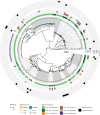Comparative genomics of quinolone-resistant Escherichia coli from broilers and humans in Norway
- PMID: 38971718
- PMCID: PMC11227169
- DOI: 10.1186/s12866-024-03412-3
Comparative genomics of quinolone-resistant Escherichia coli from broilers and humans in Norway
Abstract
Background: The usage of fluoroquinolones in Norwegian livestock production is very low, including in broiler production. Historically, quinolone-resistant Escherichia coli (QREC) isolated from Norwegian production animals rarely occur. However, with the introduction of a selective screening method for QREC in the Norwegian monitoring programme for antimicrobial resistance in the veterinary sector in 2014; 89.5% of broiler caecal samples and 70.7% of broiler meat samples were positive. This triggered the concern if there could be possible links between broiler and human reservoirs of QREC. We are addressing this by characterizing genomes of QREC from humans (healthy carriers and patients) and broiler isolates (meat and caecum).
Results: The most frequent mechanism for quinolone resistance in both broiler and human E. coli isolates were mutations in the chromosomally located gyrA and parC genes, although plasmid mediated quinolone resistance (PMQR) was also identified. There was some relatedness of the isolates within human and broiler groups, but little between these two groups. Further, some overlap was seen for isolates with the same sequence type isolated from broiler and humans, but overall, the SNP distance was high.
Conclusion: Based on data from this study, QREC from broiler makes a limited contribution to the incidence of QREC in humans in Norway.
Keywords: Escherichia coli; Antimicrobial resistance; Broiler; Core genome phylogeny; Human; Quinolone resistance.
© 2024. The Author(s).
Conflict of interest statement
The authors declare no competing interests.
Figures



References
-
- NORM/NORM-VET. NORM/NORM-VET. 2022. Usage of Antimicrobial Agents and Occurrence of Antimicrobial Resistance in Norway. Tromsø / Oslo; 2023. Report No.: ISSN:1502–2307 (print) / 1890–9965 (electronic).
-
- Norwegian Directory of Health. Antibiotics in primary care 2024 [ https://www.helsedirektoratet.no/retningslinjer/antibiotika-i-primaerhel...
-
- Norwegian Directory of Health. Antibiotics in the hospital 2024 [ https://www.helsedirektoratet.no/retningslinjer/antibiotika-i-sykehus
-
- WHO. Critically important antimicrobials for human medicine, 6th revision. Licence: CC BY-NC-SA 3.0 IGO. World Health Organization; 2019.
Publication types
MeSH terms
Substances
Grants and funding
LinkOut - more resources
Full Text Sources
Medical

